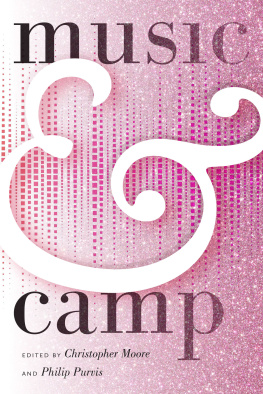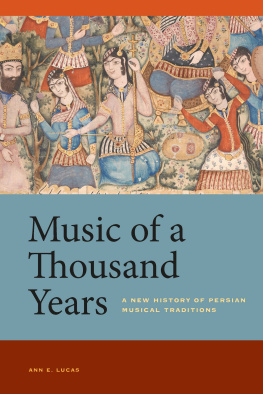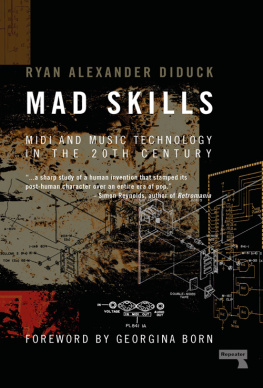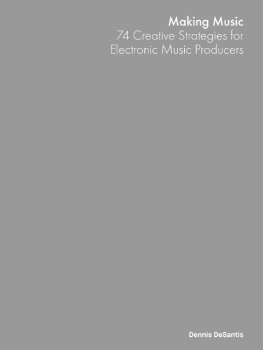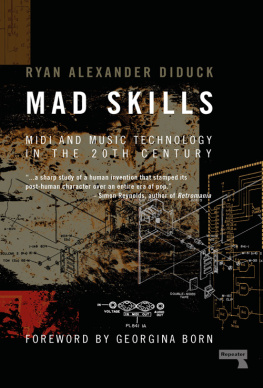Infinite
Music
Imaging the Next Millennium
of Human Music-Making
Infinite
Music
Imaging the Next Millennium
of Human Music-Making
Adam Harper
Winchester, UK
Washington, USA
First published by Zero Books, 2011
Zero Books is an imprint of John Hunt Publishing Ltd., Laurel House, Station Approach,
Alresford, Hants, SO24 9JH, UK
office1@o-books.net
www.o-books.com
For distributor details and how to order please visit the Ordering section on our website.
Text copyright: Adam Harper 2010
ISBN: 978 1 84694 924 1
All rights reserved. Except for brief quotations in critical articles or reviews, no part of this book may be reproduced in any manner without prior written permission from the publishers.
The rights of Adam Harper as author have been asserted in accordance with the Copyright, Designs and Patents Act 1988.
A CIP catalogue record for this book is available from the British Library.
Design: Stuart Davies
Printed in the UK by CPI Antony Rowe
Printed in the USA by Offset Paperback Mfrs, Inc
We operate a distinctive and ethical publishing philosophy in all areas of our business, from our global network of authors to production and worldwide distribution.
For my grandfather, who insisted he was tone deaf.
Introduction: All Worlds
To the makers of music all worlds, all times
handwritten inscription on the Voyager Golden Record
Theres a legend that sometime in the early nineteen-twenties Arnold Schoenberg, the Austrian composer regarded by many as the defining figure of musical modernism, proudly announced to his pupils Alban Berg and Anton Webern his discovery of a new compositional technique that would ensure the dominance of the German musical tradition for a thousand years. The technique was twelve-tone music, later called serialism, and it offered a method for the structuring of music to replace traditional tonalitys system of keys a harmonic convention Schoenberg had lead the way in superseding a decade before, inaugurating atonality. The twelve-tone technique treated all twelve pitches in the Western octave equally, with each of them allotted an equal presence and significance within the musical work as part of a tone row or series that incorporated them all. In the subsequent decades the method developed into serialism and the same technique was applied to other musical variables such as duration, volume and timbre, becoming highly popular with composers in Europe and America. Today, serialism has all but died out, faith in musical modernism has subsided, and the legend seems more like a joke. There probably wasnt much truth in it to begin with, and it was most likely spread and embellished by some of Schoenbergs many detractors, wishing to draw parallels with the other declarations of lasting national dominance heard during that era.
When another leading modernist composer, Karlheinz Stockhausen, died at the end of 2007 another legend was told, this time among the composers based at the university music department where I was studying at the time. Apparently in the moments immediately before his death, Stockhausen had announced to onlookers his recent discovery of a new way of breathing after which he promptly collapsed. The joke was mean-spirited, but nonetheless betrayed a certain affection for a composer whod probably done more to explore radical new musical worlds than any other, yet with little mainstream acceptance. The last movement of Schoenbergs Second String Quartet is often described as the very first example of atonality, and had featured a soprano ushering in musical modernism by singing the words: I feel air from other planets.
Both of these stories thrive on the perceived failure of twentieth-century musical modernism. Its certainly difficult to argue that it came to enjoy as much public success as its protagonists and adherents would have liked it to. Of course, many people do appreciate and value this music, but these days much of this appreciation is found among small, often academic communities who, in spite of the ground-breaking efforts of their forebears, have almost paradoxically come to hold on to some very specific ideas about which particular forms of music and methods of composition are to be preferred, ignoring the growing diversity and complexity of the many other musical styles explored more freely by the wider public. Many focus on the historical facts of musical modernism such as atonality, apparently failing to recognise that music becomes modern relative to the conditions, perceptions and conventions of its time modernism is not, in itself, a set of conventions. If music becomes conventional, its by definition no longer modernist.
This book argues that musical modernism is not a state or a set of particular techniques or characteristics, but a direction. Modernism moves away from the strictures of tradition, progressively tearing them away piece by piece and leaving them behind as it travels towards an ultimately infinite potential for musical variety. In doing so it enhances the ways in which we perceive, imagine and live in the world. But there isnt just one, general and absolute path towards the infinite point of musical modernity, an assumption that came to stifle modernist music until it became, ironically, a new orthodoxy. Rather, each path is relative to a different starting point, a different context of convention. Modernism is a multi-directional and multi-dimensional process, and there are as many paths toward musical infinity as there are ways of composing and listening.
The musical modernists of the twenty-first century should follow the spirit of serialism and not its technique, its path of innovation and not its absolute solution, its difference and not its being repeated. Serialism sought to structure the entirety of musics wider (and ultimately infinite) possibilities with an even hand. This goal remains the same. But the sheer infinity of complex musical variety is too much to be squeezed into the discrete spans imposed on single musical works. Many serialist works aimed to have it all, all the time, an attitude that usually resulted in a structuring of musical variety so diffuse that it was difficult to perceive its workings in detail. Thus musical infinity had relatively little success at the level of the musical work itself. This made little difference, many of its adherents went on to claim, because the music was for experts and not meant for the general (or else somehow coerced) intelligences of the general public. So when interest in serialism subsequently all but died, it was assumed that this was because people especially the general public didnt really want music to be new and different, and that in a wider sense, radical attempts at innovation were hopeless, or at the most the exclusive preserve of a special minority cursed with the solitude of aesthetic superiority. What if this was an illusion, an overreaction?
Whats more, serialism momentarily became the new orthodoxy because of its restrictions. Despite its noble aim to freely and equally structure the entire scope of musical variety, this variety was often permitted only for the single variable of pitch, or a limited range of the options expressed by other basic musical variables. Many serialist composers failed to perceive or challenge the even more fundamental conventions of their musical milieu: that the timbres they used were those of the instruments of Western classical music, centuries old, that the pitches and tunings they used were those of Western equal temperament and were even older. More fundamentally still, the music continued to be presented in the manner it had been for centuries: within a formal concert performance. Atonality was only one step on the road to musical modernity, and not its destination. The new musical possibilities that could be uncovered by the removal of still deeper conventions went unnoticed by many of the serialists. Other modernist composers, such as John Cage, Henry Cowell, Harry Partch and La Monte Young did travel beyond these conventions, but they didnt usually incorporate the egalitarianism of serialist techniques.



